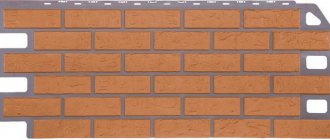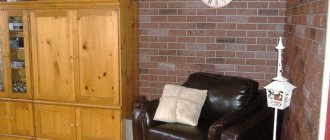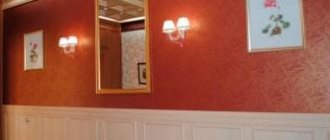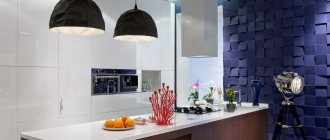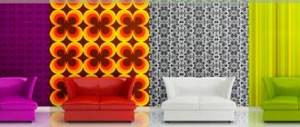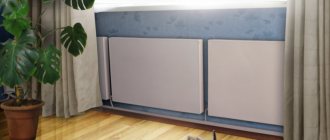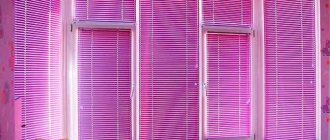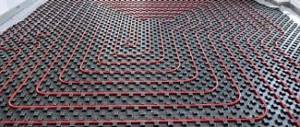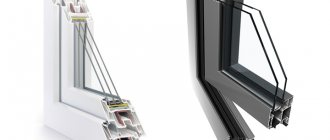- Facade panels for exterior decoration of a house: types and installation
- Advantages of façade finishing of a house
- Types of panels for facade finishing
- Facade panel materials: ceramics
- Facade panel materials: polypropylene
- Facade panel materials: fiberglass
- Facade panel materials: thermoplastic
- Facade panel materials: sandwich panels
- Installation of facade panels
- Preparatory work
- Lathing for facade panels
- Laying insulation materials
- Installation of panels on the building facade
- Video: installation of facade panels
Facade panels for exterior decoration of a house: types and installation
Cladding of buildings is the final type of construction work and is designed to give the facades of buildings external attractiveness, style and solidity. But the significance of exterior works lies not only in the fact that they decorate houses. Exterior finishing is designed to create an additional barrier to protect the walls from the effects of external adverse factors.
Facade panels: finishing the house with brick panels (read more)
Facade panels for exterior decoration of a house can advantageously highlight the architecture of a building.
This allows you to extend the shelf life of building materials. In addition, panels for finishing the facades of a house are an excellent way to insulate and soundproof a structure.
Sandwich panels not only have an attractive appearance, but also excellent characteristics.
PVC panels
Plastic panels are made of PVC or vinyl. The material is used not only for finishing, but also for insulating walls. Consists of a protective, decorative and heat-insulating layer. Plastic panels have a lot of advantages:
PVC panels for house facade
- have a low price;
- installation will require a minimum amount of plaster and primer;
- not subject to negative environmental influences;
- durable and easy to use;
- have an attractive appearance.
IMPORTANT. The thickness of the insulation in plastic panels ranges from 20 to 100 mm.
The material repels moisture well, is resistant to mechanical stress and is quite durable. Another undeniable advantage of PVC panels is that they can be painted in any desired color.
Advantages of façade finishing of a house
For this purpose, building materials have been developed and successfully used, in the manufacture of which raw materials with unusual and unique qualities are used. They combine functionality and design, strength and lightness. About facade panels for exterior decoration of a house, photos are presented in a huge variety. They give an idea of what kind of home decoration can be done and ease the problem of choice.
Ceramic panels are perhaps the most popular of all types.
Finishing with facade panels, with a huge variety of texture options, color combinations, and slab sizes, gives consumers the opportunity to use the most optimal option in each specific case.
Siding
This facing material is also widely known among designers and owners of private houses. And all due to the availability and ease of installation in comparison with other finishing materials: lining, block house, wood. However, these natural materials are difficult to work with and require additional protective treatment.
Using siding, you can turn any brick or stone house into a wooden cottage. After all, such a natural shade is attractive and to the taste of many nature lovers. Plates are available in different colors. Only the color scheme should be selected based on the color of the surrounding buildings and the roof of the house. There should be integrity and harmony in everything; too bright and unusual colors can only spoil the overall impression.
Manufacturers produce two types of siding:
- metal;
- vinyl.
Although finishing a wooden house with wall panels of this type is more expensive, it is more durable and durable. The material can withstand severe frosts without cracking. But at the same time, the panels are vulnerable to corrosion, are relatively heavy, and the sound insulation leaves much to be desired. Moreover, installation is not so easy.
But vinyl material has less strength, but you can be sure that rust will not appear. Its structure resembles wood, so it is ideal for cladding just such buildings. Various components are used for production:
- polymers;
- modifiers;
- stabilizers;
- dyes.
Thanks to this, the panels are fireproof, waterproof, and able to withstand temperature changes. But most importantly, the material does not rot, is easy to install and is inexpensive.
Types of panels for facade finishing
The shape of facade panels for exterior decoration of a house can be solid or composite. The former, due to their scale, make the process of finishing large premises less labor-intensive and speed up the work time. The panels are also produced with a different number of layers: from one to three. The peculiarity of multilayer plates is that they are stronger, more durable, and retain heat better. But the price for such facade panels for exterior decoration of a house will be higher than for products with a simplified structure.
What is DSP: application, technical characteristics (read more)
Facade panels made of thermoplastic.
Fiber cement facade panels: characteristics, dimensions (read more)
Fiber cement panels
This facing material is made of cement with the addition of ordinary plaster and microgranules that can give off or absorb moisture depending on the environmental conditions. As a rule, wall panels for exterior decoration of a house are coated on both sides with a protective coating, which improves the strength characteristics of the material. This helps to increase the service life by several decades.
When cladding houses with this material, brickwork is often imitated. And installation is so easy that the panels can be laid on your own, without the help of specialists.
The disadvantage of this cladding is the need to paint the panels after installation. They also absorb water, which can lead to slight deformation, but this does not affect the strength.
As for the cost, it depends on the design of the material itself, its thickness, and what raw materials are used in production. Some panels contain special fasteners for ease of installation - accordingly, the cost of such products will be higher.
Facade panel materials: ceramics
This type of finishing is currently considered one of the most sought after and popular. Ceramic panels, or ceramic siding, are an ideal replacement for decorative masonry. The finishing is made from a mixture based on cement and fibrous or silicate substances using special equipment. The slabs come in different sizes.
Among the features and advantages that these products have are the following:
- high thermal protection;
- non-flammability;
- are not afraid of moisture;
- resistance to temperature changes;
- environmental friendliness;
- durability;
- huge color variety.
The main disadvantage this material has is its weight. This material, compared to other facade slabs, is the heaviest.
Facade panels can imitate any finishing material.
Main characteristics of clinker panels
The first clinker panels appeared more than 40 years ago in Germany and immediately became one of the most popular materials for facade finishing. Today, there are 4 main types of clinker surfaces.
| Name | Main characteristics |
| Polyurethane foam | It has low thermal conductivity and high adhesive properties. The material is quite inexpensive and suitable for insulating walls. |
| Cement particle board - DSP | Made from wood chips and various chemical additives. It is resistant to rotting, has good density, and has high sound insulation characteristics. |
| Expanded polystyrene - EPP | Made from styrene copolymers. Widely used for insulating facades, durable and easy to install. |
| Oriented Strand Board - OSB or OSB | Multi-layer sheet made from wood chips, synthetic wax and boric acid. It has a low price, attractive appearance and high quality. |
Clinker panels have a number of positive properties:
Clinker panels for facades
- do not absorb moisture;
- the walls do not require preliminary preparation before installation;
- panels do not require special care;
- have an attractive appearance;
- have high thermal insulation characteristics.
And most importantly, you can install the panels yourself. They can be mounted on a frame made of wooden beams or metal profiles. To work, you will need a minimum set of tools, in particular dowels and screws. If additional insulation is not used, the panels are attached using a special glue that has high performance characteristics.
Facade panel materials: polypropylene
Facade panels for the exterior of a house based on polyvinyl chloride are often called basement-type siding. This material is considered widely used for finishing building facades. It is made in the form of horizontal strips, which are conveniently connected and create a single, complete surface. The finishing is very light, easy to maintain, and affordable. The appearance of houses under such material is always well-groomed and fresh. But, despite this, there are disadvantages - fragility, the need to use separate insulation, poor compatibility with other facade finishes.
Facade panels with imitation wood organically fit a country house into a forest landscape.
Brick siding: types of siding for exterior decoration of a house (read more)
Facade panel materials: fiberglass
The composition of fiberglass panels is based on fiberglass and resinous substances. With a relatively low weight, the dimensions of the slabs can be 3 m², which simplifies installation work. This material can perfectly imitate any type of finish: stone, wood, brick, etc. Collections of photos of facade panels for exterior decoration of a fiberglass house allow you to see a wide variety of texture and color range of products. Each finishing model is distinguished by its originality, strength, durability, resistance to high and low temperatures, moisture, and ultraviolet light.
Fiberglass panels can be given any shape.
The best manufacturers of PVC plates
The choice of plastic cladding materials for external walls is huge, from budget to premium options. There are high-quality products from domestic and foreign companies on the market. According to reviews from professionals in the construction industry and owners of paneled houses, the best manufacturers are:
- Dock. The company produces wood and stone cladding materials. Docke products that imitate ship planks and timber are in demand.
- Vox. The products of this company differ in decorative and quality characteristics. They have a special dirt-repellent layer. A special fastening system ensures 100% tightness.
- Alta profile. A domestic product that can withstand high and low temperatures and has a presentable appearance. Scientists from the Russian Academy of Sciences participated in the development of technical parameters of the products.
- Yu-plast. The manufacturer from Belarus attracts with its affordable price and decent quality. Panels that imitate brickwork look neat and stylish. The company uses MasterTec pigments, which give products high resistance to weathering.
- FineBer. The company's products meet international requirements. In the process of producing products, FineBer is guided by ASTM recommendations. The wood-grain coating realistically conveys the texture of the wood species.
- Novik. It gained fame thanks to the production of high-quality, durable products. Stone slabs have increased thickness.
- Dolomite. A domestic brand that produces a wide variety of facade plastic with imitation stone.
To reduce the costs of customs duties and transportation of goods, some foreign manufacturers locate production facilities in Russia. This way they were able to make their products competitive with domestic producers.
Facade panel materials: thermoplastic
This material is in demand and widely used by consumers. Made from polyester glass fibers, it can have various types of coatings. This allows you to solve any design problems in creating a unique exterior that can fit into any environment. The slabs have good strength, thermal insulation qualities, durability, and are not susceptible to mold, mildew and corrosion.
The combination of different textures when decorating a building with facade panels gives a wonderful effect.
Facade panel materials: sandwich panels
This is a multi-layer finish that is assembled from several types of materials. The product is high-strength, moisture-resistant, fire-resistant, durable. Decorates and at the same time protects the building from cold or heat. From a design point of view, sandwich panels have no limitations when implementing the most daring ideas. This is a material that fully justifies the hopes placed on it, provided that a professional gets down to business. The price of these façade panels for the exterior of a house consistently justifies the cost of manufacturing and installing the material.
Modern facade panels are visually no different from natural materials.
Installation of facade panels
This process is relatively simple. The main thing is that its implementation requires attentiveness. The main enemy of finishing panels is curvature and distortions. To work, you will need a simple and accessible set of tools: a carpenter's square, a tape measure, a hammer drill, a two-meter level, metal scissors, a hacksaw, a screwdriver, and assembly rope. The entire process of installing facade panels for the exterior of a house consists of several stages.
Scheme of external wall finishing with facade panels with insulation and vapor barrier.
Preparatory work
The surface that will serve as the base for finishing materials must be smooth and completely clear of all foreign objects of plant or technical origin. If old cladding remains on the façade, there must be a guarantee that it will not peel off in the future. All worn and unnecessary elements must be removed from the surface of the facade.
Sandwich panels imitating a wooden surface.
Lathing for facade panels
It can be constructed from various materials. These can be wooden slats or metal profiles. The technology for installing the sheathing is based on the vertical or horizontal placement of its components at a certain interval. Its configuration should ensure reliable fastening of facade panels for the exterior decoration of any type of house. The sheathing should be constructed in such a way that it does not follow the unevenness of the walls. In addition, it is necessary to leave a ventilation gap between the wall and the finish. The instructions with photos suggest looking at options on how to construct sheathing for façade panels for the exterior of a house.
Fiberglass panels surprise with a variety of textures.
Ventilated facade of a house: design of a facade system (read more)
Wall cladding: step-by-step instructions
PVC panels are an easy-to-use material. However, a novice master may need instructions. Step-by-step photos will help you complete wall cladding without the help of professionals.
Step 1. Installation begins with the installation of the sheathing. Depending on the material, a wooden or metal frame is used. First, install vertical guides at a distance of approximately 40 cm, then attach horizontal ones from the corners. The PVC plate tends to follow the unevenness of the frame, so all work is carried out using a level.
Installation of sheathing
The metal frame is stronger and more durable
Step 2. Metal siding is equipped with corners.
Fastening the corners
Step 3. As an additional insulation, a layer of insulation is laid under the sheathing. For example, mineral wool or other material.
Laying insulation
Thermal insulation materials
We suggest you familiarize yourself with How to fix PVC panels in corners
Step 4. Installation of panels begins from the lower left corner of the wall. Installation is carried out on top of installed drains and corner risers. The panels will be adjacent to these elements. The first step is to attach the starting bar. To do this, a nail is driven into the very bottom of the wall. A second one is driven into the opposite corner using a level and a rope.
Under no circumstances should distortions be allowed!
Step 5. Corner risers are installed first. To do this, at the top of the wall, the first element is nailed on both sides, without driving them in completely. The riser is centered and then nails are driven in at a distance of 2-3 cm. To better join the corners, each lower element is inserted 3 mm under the upper one. This will prevent water from seeping under the casing.
We start installation from the corners
Step 6. The direction of the subsequent ones depends on the first row, so special attention is paid to installing it. Subsequent rows are inserted into the grooves of the previous one. For joints, use glue recommended by the manufacturer. The panels themselves are attached with screws.
Measure it seven times!
Laying insulation materials
The finishing material itself is already a barrier that can reduce thermal energy losses in the house. But if, thanks to the sheathing, a cavity appears between the facade panels for the exterior of the house and the wall, it is recommended to fill it with insulating material. For this you can use any type of mineral wool or polystyrene foam. Before installing the sheathing, it is recommended to install a hydrobarrier or regular thick cellophane film.
Polypropylene facade panels look very neat. After the façade insulation has been placed, it is advisable to cover it with a wind barrier along with the entire sheathing structure. Despite the fact that the slats will be hidden, their placement will not be difficult to determine by touch in order to screw finishing panels to them. Thin fabric can be used as a wind barrier, the main thing is to create an obstacle to drafts. But the main insulating effect will depend on the thickness of the layer and the quality composition of the heat insulator.
Facade panels are easier to install and are much lighter in weight than the natural stone they imitate.
Installation features
As I said above, installing PVC panels does not require special knowledge, but there are still a few subtleties.
Here is a list of tools that you will definitely need:
- elements for fastening the structure;
- the sharpest knife in the house;
- saw;
- jigsaw
Installation of facade panels
If the surface of the sheet has unevenness on the inside, we recommend attaching the sheets not to the facade, but to a wooden frame. Before you start doing anything, be sure to tidy up, wash the walls, insulate them if necessary, and seal the cracks. In order to do everything perfectly, you must first make a so-called starting rail, located around the entire perimeter of the house in a horizontal position. It is better to fasten the panel with dowels or self-tapping screws. The distance from the blind area to the bottom edge of the structure should be at least 3-4 centimeters; it should not be done end-to-end, otherwise the PVC sheet may be damaged in winter. Plastic panels are not only practical, but also a fashionable, modern solution for facade finishing. Thanks to them, you can make your home more respectable. It is worth noting the fact that the installation of PVC panels occurs at a temperature not lower than 10 degrees. If the plastic sheets were in a colder place before installation, I recommend putting them in a warm place for at least two days.
Installation of PVC panels
The panels are attached to a previously made sheathing, the pitch of which is at least 0.5 meters. The sheathing should be perpendicular to the panel, that is, if it is mounted horizontally, the grille should be vertical, and vice versa. If desired, you can further insulate the building by filling the space between the wall and the PVC plate. The starting profile clings to the corner of the building, from there, in fact, the installation of PVC panels begins. What exactly to mount it on – decide for yourself. I can recommend glue, special mixtures, staples, screws and regular nails. If you decide to use mixtures or glue, be sure to check the temperature conditions for use. This is necessary so that in very hot or cold weather the panels do not come off.
https://youtube.com/watch?v=YUixScazpCQ
Installation of panels on the building facade
Work should begin from the lower tier of the profile. The photos attached to the instructions explain quite clearly how to attach facade panels for the exterior of a house. The panels are joined together using tongue and groove, and then screwed to the sheathing using self-tapping screws. Professionals recommend using self-tapping screws with a small head and a length that will ensure reliable fixation of the panel to the sheathing.
Facade panels have excellent performance characteristics.
We hope that our information will help you make the right choice of cladding panels for your home, as well as carry out insulation measures productively.
Following the manufacturers' instructions, this will not be difficult to do. As a result, you will realize an additional feature that will help you make your home cozy and warm in winter, as well as fresh and cool in the summer heat. How to decorate the outside of a house: choice of material, methods and types of finishing (read more)
At customer's choice
Now the market for building materials for house facades has the opportunity to satisfy the most demanding customer.
On it you can find cladding panels for facades of various shapes and colors, different compositions and very different prices.
The most common types of facade panels include:
- Plastic;
- Made from natural wood;
- Made from laminated wood;
- Insulating porous composition;
- Fiber cement;
- Ceramic.
Even façade wooden panels do not always withstand competition. Natural, expensive compositions of panels for facades have long been successfully replacing new, artificial materials.
New decorative inexpensive panels for facades are both more durable and allow manufacturers to carry out a wide variety of artistic shaping of elements using inexpensive equipment.
Wall panels for external facades usually do not require surface treatment - priming, puttying or painting.
The required properties of surfaces - color and shape - are set by the manufacturer during the production process. This determines their construction value.
After all, decorative facade panels are easy to install and can create an individual ornament without the involvement of design specialists.
